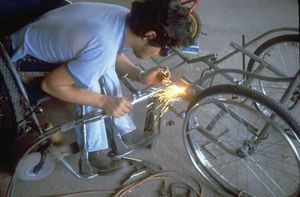Hesperian Health Guides
People with Disabilities as Leaders and Workers in Rehabilitation Activities
HealthWiki > Disabled Village Children > Chapter 45: Starting Village-Based Rehabilitation Activities > People with Disabilities as Leaders and Workers in Rehabilitation Activities
 |
| Workers with disabilities give an example to children with disabilities that they can lead a full life. Polo Leyva, a person with paralysis due to polio, has become a skilled welder and wheelchair maker. |
Another reason for recruiting leaders and workers who are mostly people with disabilities (or their relatives) is that they are more likely to work with commitment, to give of themselves. From their own experience, they understand the challenges, needs, and possibilities of people with disabilities. Because they, too, have often experienced rejection, misunderstanding, and unfair treatment by society, they are more likely to become leaders in the struggle for a fairer, more fully human community.
Examples of community rehabilitation programs run by people with disabilities are in Chapter 55.


